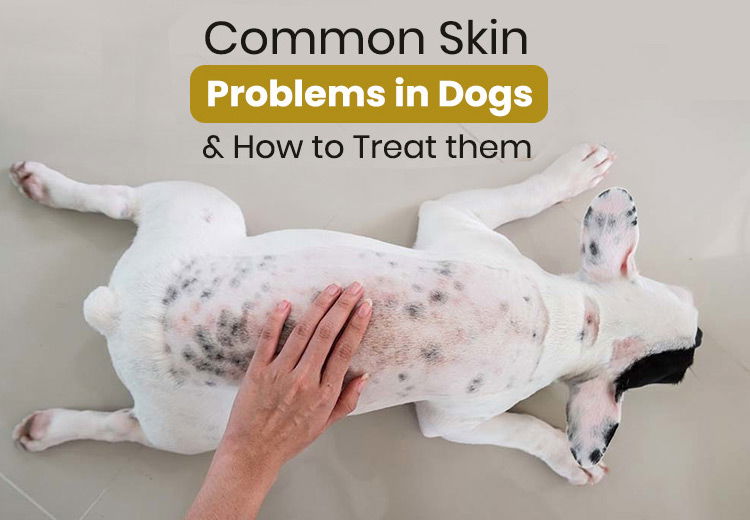 Aug 11, 2021
Aug 11, 2021

Imagine how you’d feel with a constantly scratching and itching skin. Our dogs are no different. Skin irritations in dogs might indicate skin disorders which have a negative impact on your dog's quality of life.
If you don’t want your dog to suffer from painful skin problems, you should be aware of the symptoms so that you can diagnose them early on. Here's everything you need to know about the most common skin problems in dogs, including their signs, symptoms and treatment options.
Depending on the etiology, a skin disease can range from moderate to severe and its symptoms may differ depending on the severity. If you notice any of the following symptoms on your dog's skin, schedule an appointment with your veterinarian right away; waiting might lead to more serious concerns.
· Rashes
· Swelling
· Raised bumps
· Blisters
· Redness
· Discoloration
· Bald patches
· Dry or flaky skin
· Lumps
· Lesions
· Smelly, weepy skin
· Scaly patches
· Hot spots (areas with severe itching)
Allergies are one of the most common causes of skin issues in dogs. Allergens such as dust, pollutants, pollen, smoke, chemicals, and so on can trigger allergies. It may also occur due to food allergens like wheat, soy, corn, milk and some specific proteins. Allergies can cause itching, redness, rashes, sneezing, coughing, digestive issues, etc and may even worsen with time if left untreated. Your vet may suggest the use of certain treatments to alleviate the symptoms, but the most effective treatment is to identify the allergen and avoid its exposure.
Most probably, your dog's itchy skin may be because of dry skin. To check if your dog has dry skin, part the fur and look for scaly or flaky skin. Dry skin may occur as a result of allergies, dehydration or nutritional deficiencies. Your veterinarian may recommend moisturizing creams or skincare supplements, such as the Essential 6 in this case.
Also known as pyotraumatic dermatitis, hot spots are basically areas of sudden acute localized inflammation. Hot spots can be severely painful and may cause excessive scratching. They're generally found on a dog's chest, hips, or head, and can be caused by allergies, bug bites, infections, or frequent licking. The hot spots need to be cleaned, bandaged and treated immediately to avoid worsening of the condition, so take your dog to the vet immediately if you suspect one.
While there are numerous pesky parasites out there to cause skin issues for your dog, fleas and ticks are the most common ones. They may sneakily invade your dog’s skin and lead to skin problems. Fleas leave behind flea dirt, which causes irritation and itching, while ticks gorge themselves with your dog’s blood by sticking to their skin. In such cases, it is best to eliminate the fleas and ticks, and the symptoms along with them. There are many powerful flea & tick treatments available to fight and prevent these hitchhikers, so reach out to your vet today for a recommended treatment.
The Ringworm, contrary to its name, is a fungus, and not a worm. The circular patches that grow on the afflicted dog's skin are referred to as "rings". Scaly skin, bald patches, and inflammation surrounding the rings are all symptoms of ringworm in dogs. Ringworm is common in puppies, and it can be transmitted between dogs in shelters and boarding kennels. If you suspect any of the symptoms of this disease, contact your vet right away for an appropriate course of antifungal treatment.
Yeast infections are very common skin infections in dogs. If your dog is scratching or licking their ears or chewing their toes continuously, they might be infected with yeast. The infection commonly affects the paws and ears, which provide an ideal environment for yeast to thrive. Symptoms include skin irritation, itching and discolored skin. Yeast infections are simple to identify and can be treated easily with a topical treatment.
Although it is not uncommon for dogs to shed, a dog’s hair loss might be accelerated by stress, inadequate nutrition or other health problems. If you find patches of hair loss or excessive shedding, seek your vet’s consultation immediately.
A dog’s skin becomes oily and scaly (dandruff) in the case of seborrhea. It's a genetic condition that starts when a dog is young and lasts for a lifetime in certain situations. Most dogs with seborrhea, on the other hand, develop scaling as a result of another medical condition, such as allergies or hormone imbalances.
Skin problems in dogs are one of the most prevalent and addressed problems, with a variety of treatment options like antiseptic shampoos and ointments. If your pet's skin problem persists after a few days or if you notice blood or pus oozing from their skin, you should take them to the veterinarian as soon as possible. If your dog doesn’t have any of the symptoms described above but you're still concerned, do not hesitate to contact your veterinarian.
Meanwhile, you can also invest in a dog t-shirt, Elizabethan collar or bitterant to keep your dog from licking or scratching himself until the vet recommends a proper treatment.